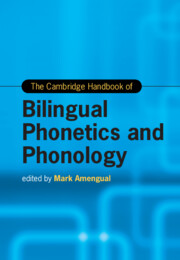Book contents
- The Cambridge Handbook of Bilingual Phonetics and Phonology
- Cambridge Handbooks in Language and Linguistics
- The Cambridge Handbook of Bilingual Phonetics and Phonology
- Copyright page
- Dedication
- Contents
- Figures
- Tables
- Contributors
- Acknowledgments
- Introduction Bilingual Phonetics and Phonology
- Part I Approaches to Bilingual Phonetics and Phonology
- 1 Generative Approaches to Bilingual Phonetics and Phonology
- 2 Usage-Based Approaches to Bilingual Phonetics and Phonology
- 3 Sociolinguistic Approaches to Bilingual Phonetics and Phonology
- 4 Psycholinguistic Approaches to Bilingual Phonetics and Phonology
- 5 Neurolinguistic Approaches to Bilingual Phonetics and Phonology
- 6 Computational Approaches to Bilingual Phonetics and Phonology
- Part II Theoretical Models of Bilingual Phonetics and Phonology
- Part III The Phonetics and Phonology of the Bilingual Child
- Part IV The Phonetics and Phonology of the Bilingual Adult
- Part V The Diversity of Bilingual Speakers
- Part VI Variables and Outcomes of Bilingual Speech
- Index
- References
6 - Computational Approaches to Bilingual Phonetics and Phonology
from Part I - Approaches to Bilingual Phonetics and Phonology
Published online by Cambridge University Press: 14 November 2024
- The Cambridge Handbook of Bilingual Phonetics and Phonology
- Cambridge Handbooks in Language and Linguistics
- The Cambridge Handbook of Bilingual Phonetics and Phonology
- Copyright page
- Dedication
- Contents
- Figures
- Tables
- Contributors
- Acknowledgments
- Introduction Bilingual Phonetics and Phonology
- Part I Approaches to Bilingual Phonetics and Phonology
- 1 Generative Approaches to Bilingual Phonetics and Phonology
- 2 Usage-Based Approaches to Bilingual Phonetics and Phonology
- 3 Sociolinguistic Approaches to Bilingual Phonetics and Phonology
- 4 Psycholinguistic Approaches to Bilingual Phonetics and Phonology
- 5 Neurolinguistic Approaches to Bilingual Phonetics and Phonology
- 6 Computational Approaches to Bilingual Phonetics and Phonology
- Part II Theoretical Models of Bilingual Phonetics and Phonology
- Part III The Phonetics and Phonology of the Bilingual Child
- Part IV The Phonetics and Phonology of the Bilingual Adult
- Part V The Diversity of Bilingual Speakers
- Part VI Variables and Outcomes of Bilingual Speech
- Index
- References
Summary
Computational models allow researchers to formulate explicit theories of language acquisition, and to test these theories against natural language corpora. This chapter puts the problem of bilingual phonetic and phonological acquisition in a computational perspective. The main goal of the chapter is to show how computational modeling can be used to address crucial questions regarding bilingual phonetic and phonological acquisition, which would be difficult to address with other experimental methods. The chapter first provides a general introduction to computational modeling, using a simplified model of phonotactic learning as an example to illustrate the main methodological issues. The chapter then gives an overview of recent studies that have begun to address the computational modeling of bilingual phonetic and phonological acquisition, focusing on phonetic and phonological cues for bilingual input separation, bilingual phonology in computational models of speech comprehension, and computational models of L2 speech perception. The chapter concludes by discussing several key challenges in the development of computational models of bilingual phonetic and phonological acquisition.
Keywords
- Type
- Chapter
- Information
- The Cambridge Handbook of Bilingual Phonetics and Phonology , pp. 126 - 144Publisher: Cambridge University PressPrint publication year: 2024

